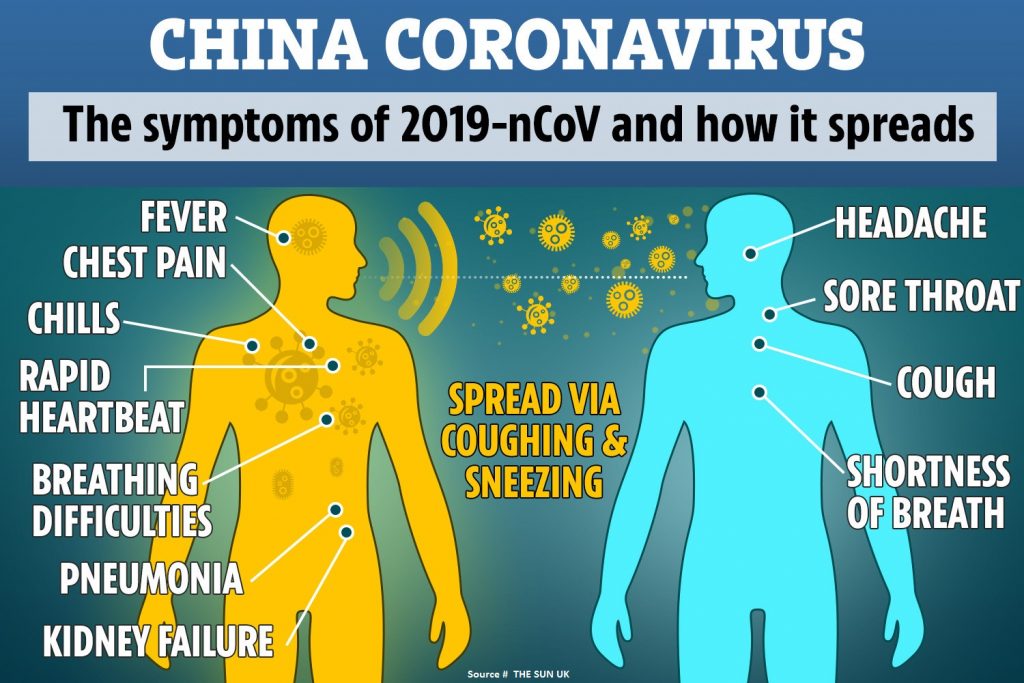In December 2019, Chinese officials reported a viral outbreak of several cases of pneumonia. The disease was caused by a mutation of the Coronavirus. The coronavirus is usually found in animals. However, this novel case was the first of its kind in humans. Since its spread, the disease has now been found to spread through human to human contact.
Sign and symptoms of coronavirus:
As this deadly virus is spreading throughout the world, that’s why doctors are getting capable of understanding the symptoms and looking for the warning signs associated with this disease.
According to the foreign policy reports, extreme cases of coronavirus involves coughing up of blood, or they might undergo the septic shock. Whereas, in mild to moderate cases, symptoms stay milder, which can let the disease hidden, leading to worsening of the situation.
Coronavirus can also cause pneumonia, some respiratory complications, and even cardiovascular diseases.
Most common symptoms of this virus are:
- Fever
- Coughing
- Soreness
- Fatigue.
As its breakouts are mostly in the mid-flu season, which makes it difficult to differentiate from the flu. As this virus proceeds, it can result in symptoms’ severity as:
- Difficulty in breathing or shortness of breath (SOB).
- Injury to kidneys or kidney failure.
- Impaired kidney and liver function.
- The incubation period of unknown duration.
- Severe cough
- Heart damage
- MERS or (Middle-East Respiratory Syndrome) – which was first identified in Saudi Arabia in the year 2010. This disease has been spread to almost 27 countries, while 2494 cases were confirmed for the disease.
- SARS (Severe Acute Respiratory Syndrome).
In the elderly population, this virus can prove itself to be deadliest. In the already sick or elderly population, the mortality levels of this disease are relatively higher in comparison to other viruses.
The symptoms of this disease can stay hidden for about two weeks, which makes its screening difficult in comparison to most of the viral infections, which tend to show their signs and symptoms within the early few days.

Causes:
Researchers are working hard to find the exact cause and source of coronavirus. Coronaviruses belong to a vast family of viruses, which causes illnesses in people and let them circulate among various animals, including bats, cats, and camels.
Genetic tree analysis of the disease and virus can let us know about the specific source of this virus. Another form of coronavirus known as SARS (Severe Acute Respiratory Syndrome) originates from civet cats, while another form as MERS (Middle East Respiratory Syndrome) comes from camels.
Originally, this virus spreads from the animal’s source but can also transfer from one person to another. In person-to-person transfer, it is essential to keep in mind that it happens on a continuum. Some viruses tend to be extremely contagious, while some viruses are not capable of extreme spread.
Coronavirus is mostly active during the winter season, but it can also stay active during other seasons. The young population can also come in contact with this disease and even get affected by more than one infection. Coronavirus can also spread from one individual to another in the following ways:
- Sneezing or coughing without covering your mouth, which can disperse the disease droplets in the air.
- Shaking hands or touching an affected person.
- Making physical contact with an affected object or any surface and then touching your own nose with that hand.
- In some cases, it is believed that this virus transmits from the secreted fluid of the respiratory system.
- In some rare cases, this virus can also spread from coming in contact with feces.
Prevention:
Currently, there isn’t any vaccine available to treat this infection. The best way to avoid this infection is to prevent exposure to this certain virus.
In accordance with the CDC or (Centers for Disease Control and Prevention), the following are the preventive measures which can help in the prevention of disease spread:
- Wash your hands with water and soap at least for 20 seconds. If water or soap isn’t available, then you can use an alcohol-based sanitizer as well.
- Avoid touching your nose, mouth, and eyes with dirty or unwashed hands.
- Avoid close physical contact with sick on infected individuals.
- If you get infected with the virus, you should prefer staying at home.
- You must cover your mouth with a cloth or tissue while sneezing or coughing.
- Disinfect and clean the objects and surfaces which are frequently touched.

Travelers who are traveling from different countries to China should follow the following precautions:
- Avoid unnecessary visits to the city of disease origin Wuhan.
- Avoid unnecessary contact with sick individuals.
- Before traveling there, discuss your health status with health care providers as the older population is more at risk of getting infected.
- Avoid contact or consumption of dead or alive animals, animal markets, and all the products coming from animals as uncooked meat products.
- If you have done a recent visit to China and you feel some symptoms of fever with a cough, then you should go for medical care, and even before consulting some hospital, let them know about their symptoms.
- Do not travel while being sick and avoid any type of contact with others.
Risks:
As the coronavirus is a contagious disease, it has several risk factors:
- Close contact or physical contact with the infected person or breathing in an infected environment (as this virus is transmitted through the airborne transmission of droplets released as a result of coughing and sneezing).
- Chinese people are more fond of eating unusual animal food, which makes them more susceptible to getting infected from the virus as in bats, rats, cats, and camels. Anyone who has recently traveled to China can be a risk factor for this disease as the transmission rate of this virus is relatively higher.
- This disease basically originated from Wuhan, China, and other cities experienced its outbreak; that’s why China and the Chinese population or travelers are currently a threat to the world for the spread of this disease.
- Coming in contact with body fluids or secretions of the infected person as sneezing and coughing droplets or fluids of the respiratory system is the most significant risk factor for this disease.
- People who are already sick or infected with some other disease and elderly population are more prone to developing this disease as their immunity is already weak on account of previous infections or aging body.
- Other than humans, contact with animals, especially in an open market of seafood animals and other raw meat.
- This virus is capable of being transmitted to about 16 countries within the smallest duration of one month.
